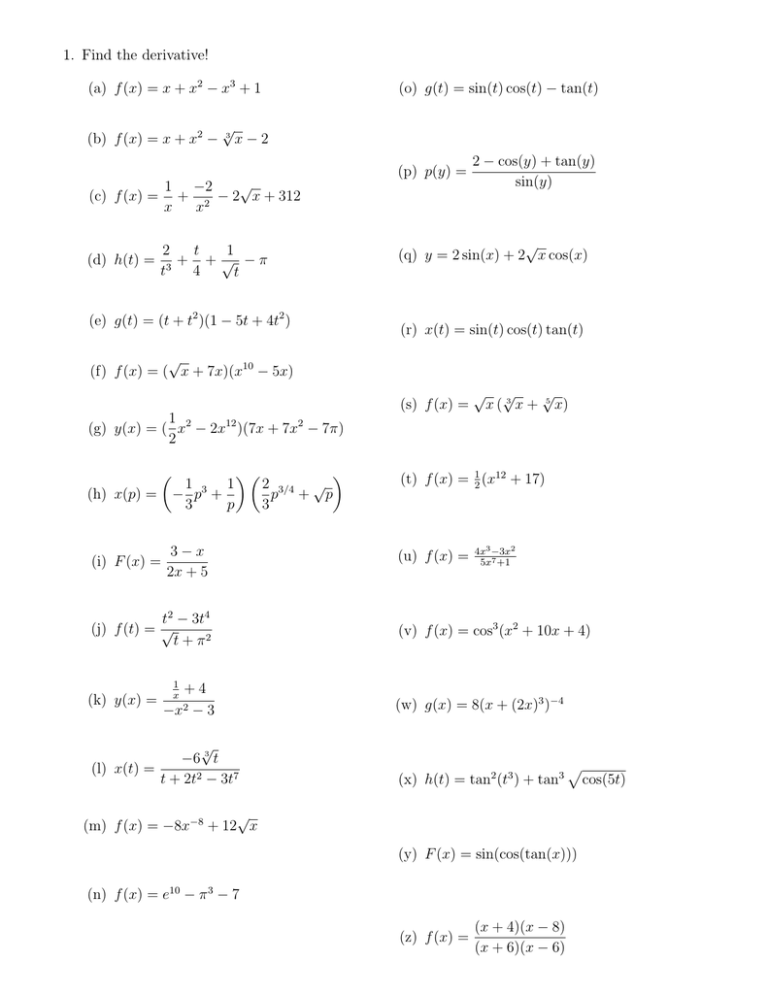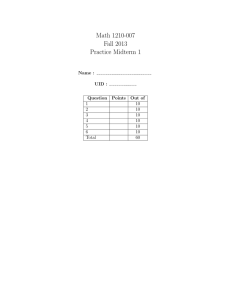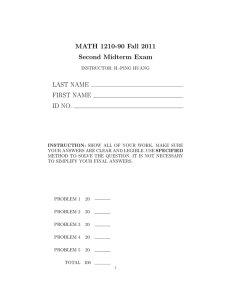1. Find the derivative! − x + 1
advertisement

1. Find the derivative! (a) f (x) = x + x2 − x3 + 1 (b) f (x) = x + x2 − √ 3 (o) g(t) = sin(t) cos(t) − tan(t) x−2 (c) f (x) = √ 1 −2 + 2 − 2 x + 312 x x (d) h(t) = 2 1 t + + √ −π 3 t 4 t (p) p(y) = 2 − cos(y) + tan(y) sin(y) √ (q) y = 2 sin(x) + 2 x cos(x) (e) g(t) = (t + t2 )(1 − 5t + 4t2 ) (r) x(t) = sin(t) cos(t) tan(t) √ (f) f (x) = ( x + 7x)(x10 − 5x) (s) f (x) = √ √ √ x ( 3 x + 5 x) 1 (g) y(x) = ( x2 − 2x12 )(7x + 7x2 − 7π) 2 (h) x(p) = (i) F (x) = 1 1 − p3 + 3 p 3−x 2x + 5 t2 − 3t4 (j) f (t) = √ t + π2 (k) y(x) = 1 x +4 −3 −x2 √ −6 3 t (l) x(t) = t + 2t2 − 3t7 2 3/4 √ p + p 3 (t) f (x) = 21 (x12 + 17) (u) f (x) = 4x3 −3x2 5x7 +1 (v) f (x) = cos3 (x2 + 10x + 4) (w) g(x) = 8(x + (2x)3 )−4 (x) h(t) = tan2 (t3 ) + tan3 p cos(5t) √ (m) f (x) = −8x−8 + 12 x (y) F (x) = sin(cos(tan(x))) (n) f (x) = e10 − π 3 − 7 (z) f (x) = (x + 4)(x − 8) (x + 6)(x − 6) 2. Use the table to answer the following: x −2 4 f (x) 4 3 f 0 (x) 1 7 (a) Find (b) Find (c) Find (d) Find 3. Find dy dx d (x3 f (x)) at x = −2 dx d ( x ) at x = 4 dx f (x) d (f (f (x)) at x = −2 dx d (f (x2 )) at x = −2 dx for the following: √ (a) xy = x + 3y (b) 4 sin(2y) cos(x) = 2 (c) x sec(y) = xy (d) xy 2 − tan(πxy) = 2x x − y 2 = cot(x) (e) 2y 4. Determine the equation of the tangent line to the curve at the point (1, 1). 5. Create a graph of a function that satisfies the following: • f (−3) = 0 • f (0) = 0 • lim f (x) = 3 x→1 • f (1) does not exist 0 • f > 0 on (−3, −1.5) • f 0 = 0 at x = −1.5 • f 0 < 0 on (−1.5, 0) • • lim f (x) = 0 x→−3− lim f (x) = 1 x→−3+ • lim f (x) = 0 x→∞ • lim f (x) = ∞ x→−∞ S S • Continuous on (−∞, −3) (−3, 1) (1, ∞) • Not differentiable at x = −3, 0, 1 6. Write the full statement of the Mean Value Theorem (MVT). When can the MVT be used? In your own words, state what the conclusion of the MVT implies. 7. Using the MVT: Find the value c that satisfies the equation in the conclusion of the Mean Value Theorem for the function f (x) = x2 on [1, 5]. Why can we apply the Mean Value Theorem to this function? What if we had h(x) = |x| on [−1, 1]? [0, 1]? 8. Find the absolute maximum and minimum values of the function on the given interval. (a) f (x) = 53 x + 1, −1 ≤ x ≤ 3 √ (b) g(x) = 9 − x2 , −3 ≤ x ≤ 1 (c) f (θ) = 3 sin(θ), − π2 ≤ θ ≤ 7π 6 9. Multiple Choice: f (x) = 3|x + 2| does not have a derivative at x = −2 because (a) x = −2 is not in the domain of f (x). (b) lim− f (−2 + h) − f (−2) f (−2 + h) − f (−2) = −3 and lim+ = 3, so f 0 (−2) does not exist. h→0 h h (c) lim− f (−2 + h) − f (−2) f (−2 + h) − f (−2) = −∞ and lim+ = ∞, so f 0 (−2) does not exist. h→0 h h h→0 h→0 (d) The tangent line is horizontal at x = −2. (e) None of the above. 10. Multiple Choice: The derivative of f (x) = x|x| at x = 0 (a) is 0 (b) does not exist because |x| is not differentiable at x = 0. (c) does not exist because f (x) is defined piecewise. (d) does not exist because the left and right hand limits do not agree. (e) None of the above. 11. Given y = g(x), write out the formal definition for the derivative of g(x) evaluated when x = 3. Draw a sketch and label all the components of the definition on your sketch to indicate that you understand where the definition of derivative comes from. (See HW4.) 12. Use the function f (x) = x to answer the following: |x| + 1 (a) What is the domain of f (x)? (b) Sketch the graph of f (x) in the axes provided below. (c) Use the definition of the derivative to determine if f (x) is differentiable at x = 0. (d) The function, f (x) IS / IS NOT (circle one) differentiable at x = 0? Explain in 1-3 sentences how you reached this conclusion. 13. True/False (see also HW 6 problem 4, old exams) (a) If the derivative does not exist at a point, then a tangent line cannot exist at that point. (b) f (x) = |x + 5| is not differentiable at every x in its domain. (c) If f (x) is defined on [0, 6], then it must attain both an absolute maximum and an absolute minimum value on [0, 6]. 14. Below is the graph of a function that changes with respect to time. Which of the following statements are accurately modeled by the graph? (CIRCLE ALL CORRECT RESPONSES) For each response that you circle, fill in the blank with the function represented by the graph (position, velocity, or acceleration). (a) Olga climbs to the top of a mountain of height M but quickly descends to a shelter halfway down when she sees a thunderstorm on the horizon. She arrives at the shelter at time tF . (b) Tatiana is jumping on a trampoline until her foot slips and she falls to the ground at time tF . (c) Alexie accelerates from a stop sign before reaching a school zone and needing to slow down to a legal speed. (d) Maria’s plane accelerates for take-off, reaches cruising altitude, slows down to a constant speed, and stays there for the rest of the flight. (e) Anastasia is proud of her efforts during the Fort Collins Marathon, since she maintained a constant pace. She was quite proud of her running time of tF = 3 hours. Was position, velocity, or acceleration not accounted for in any the above stories you chose? If so, provide a brief story that illustrates the missing “thing” to go along with the graph. 15. Discuss everything you know about the relationship between continuity and differentiability. 16. Sketch the graph of a function that satisfies the following: (a) lim f (x) = ∞ x→−∞ (b) lim f (x) = −∞ x→∞ (c) lim f (x) = ∞ x→−2 (d) lim− f (x) = −∞ x→2 (e) lim+ f (x) = 2 x→2 (f) lim f (x) = 4 = f (4) x→4 0 (g) f (4) does not exist (h) f 0 (x) > 0 for −4 < x < −2 and 2 < x < 4 (i) f 0 (x) < 0 for x < −4 and −2 < x < 2 and x > 4 17. Compute the following derivative: d dx s 2x · 1 + sin(x) cos(x) − tan(3x) !






